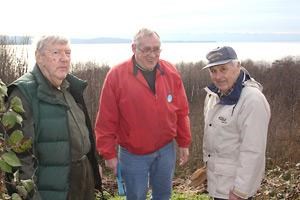City of Powell River staff have been directed to revise a draft public consultation plan for the liquid waste management plan.
The joint technical-local advisory committee approved a draft plan, which included provision for an open house, at which available information about all options would be displayed. The committee also recommended that a second meeting, using a facilitator, be held following the open house, to provide the public with an opportunity to ask questions and air concerns.
City staff approached Geoff Allan, a certified professional facilitator, to discuss the draft plan. After meeting with Richard Stogre, manager of engineering services, and Councillor Jim Palm, Allan suggested that the whole public consultation process should be reviewed. Allan also addressed members of the liquid waste management steering committee on February 3.
“You don’t consult the public directly on an issue if you don’t really expect that they will have an opportunity to influence a decision,” Allan said. “As soon as you go out and engage the public in dialogue beyond an information exchange, you create an expectation that what they pass on to you is information that can change a decision.”
An open house is a useful way to pass information to the public, Allan said. However, the second part, a town hall meeting, with people on the stage and an opportunity for “people to stand up and present to you what they think is essentially wrong with what you’re doing, that’s not a dialogue,” Allan said. “There is a place for a town hall meeting but it really depends what it is you want to get out of it.”
Once the city decides what it wants to achieve by going out and talking to the public, Allan said, he can design a process to achieve that goal. “The existing proposal of having the Evergreen Theatre packed with people standing at mikes and all of you with targets on your forehead on the stage is not useful to anyone,” he said. “I’m encouraging you to move beyond that.”
After discussing the issue, the committee passed a motion directing staff to develop a comprehensive community public consultation process in advance of site selection.
Meanwhile, members of the advisory committee, some city councillors, staff and the Peak toured potential sites on February 1. Participants travelled in a city bus to the Townsite treatment plant, Catalyst Paper Corporation’s old primary clarifier, Catalyst’s effluent treatment plant and the former waste transfer site. The bus stopped at the viewpoint in Townsite so participants could view how close the old primary clarifier is to houses across Marine Avenue. The bus also stopped on Larch Avenue to show participants the Townsite treatment plant can’t be seen from there.
At the old waste transfer site, Stogre explained the site contained piles of ash, Gyproc and any number of unknown contaminants. The last report the city received about the site recommended it study the area.
In terms of locating a consolidated plant on the site, Stogre said, further studies and cleanup would add to the costs. “The other way to look at it is the city has to deal with this someday and maybe this is the motivator to get it done,” he said.
The tour was organized in order for committee members to rate the social components of each site on a ranking matrix. Committee members discussed the matrix again at the January meeting. Al Gibb, consulting engineer with Dayton and Knight Ltd., pointed out that the economic section of the matrix contained factors that would give full points to co-treatment and none for the other options. Committee members couldn’t remember when these factors were added to the matrix and asked staff to bring forward the motion that established the description and points.
Treatment options
City of Powell River is in stage three of developing a liquid waste management plan. The options being considered are:
• Consolidated plant located at the Townsite treatment plant. Wastewater from the Townsite area would continue to flow there much in the same way it does now. The Westview plant would be replaced by a pump station and wastewater would be pumped along one of four forcemain routes to Townsite. The Townsite plant would be replaced with a new facility and a new outfall would have to be constructed.
• Consolidated plant at waste transfer site. The existing Townsite plant would be replaced with a pump station. Sewage from Townsite would continue to flow to the pump station much in the same way it does now, but would then be pumped up to a forcemain on the haul road to a new interceptor along Marine Avenue then on to the waste transfer site. Westview treatment plant would be replaced by a pump station and sewage would be pumped along Marine Avenue to the new treatment plant. There would be a new outfall.
• Co-treatment at Catalyst Paper Corporation’s mill. A new pre-treatment plant would be located at the old primary clarifier site in Townsite. All of the wastewater from Westview would be pumped to Townsite. There would be a pump station at the location of the existing Townsite treatment plant that would pump the wastewater up to the pre-treatment plant for screening and grit removal. Pre-treated wastewater would go into pump station H then up to the mill’s treatment plant.
• Consolidated plant at Catalyst’s old primary clarifier for secondary treatment. This system would be the same as the co-treatment design, except the old primary clarifier would be retrofitted for secondary treatment, instead of using the mill’s treatment plant.



